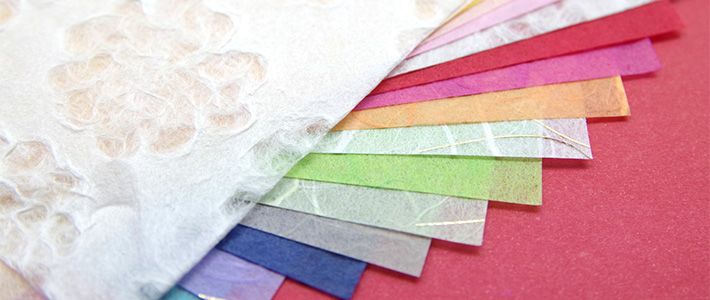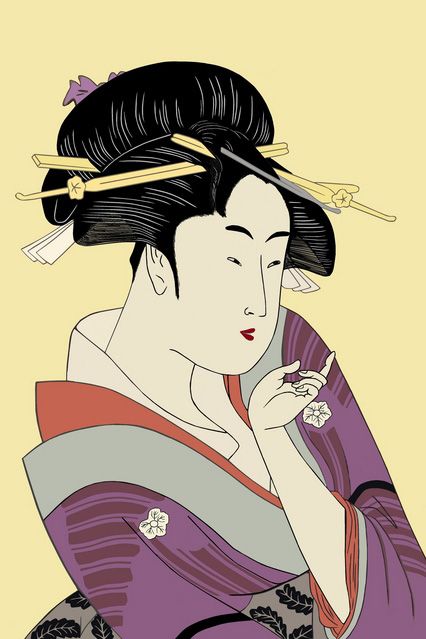
“Washi” (Japanese Paper)
Society Culture- English
- 日本語
- 简体字
- 繁體字
- Français
- Español
- العربية
- Русский
Strong Paper for More Than Writing and Drawing
Traditional handmade Japanese paper is collectively known as washi. It has an understated translucency and subtly irregular texture, which is pleasant to the touch. It is also strong, absorbent, and long-lasting, making it suitable for applications going well beyond writing and drawing. Classic shōji sliding doors make use of washi, as do lanterns, such as those at yatai food stalls, many home lighting fixtures, folding fans, and traditional umbrellas. During the Edo period (1603–1868) the availability of sturdy, handmade paper enabled ukiyo-e woodblock prints to develop into a defining aspect of popular culture.
 Ukiyo-e prints, such as this example by Utamaro (1753–1806) were made using washi.
Ukiyo-e prints, such as this example by Utamaro (1753–1806) were made using washi.
Washi has for centuries also garnered attention beyond Japan’s borders. The Dutch painter Rembrandt was already experimenting with washi around 1650, long before the Japonism boom in Europe. Pablo Picasso and Marc Chagall were among the later artists to fall under the spell of Japanese paper. Its strength, durability, and other properties have also made it an essential element in many art preservation projects, including the restoration of Vatican frescoes.
The art of making paper by hand arrived in Japan with Buddhism from China, being a vital part of producing scriptures. As the new religion spread across the country, encouraged by the influential regent Prince Shōtoku (574–622), so did paper. In the Heian period (794–1185), Japan developed its own distinctive nagashizuki method of papermaking. In this method, a wooden screen is repeatedly dipped in liquid containing plant fibers and gently shaken to spread the liquid evenly, thus binding the fibers and creating a durable form of tear-resistant paper. By comparison, Japanese-style paper made by machines is good for writing and printing, but is more susceptible to damage and discoloration.
Visiting Washi no Sato (Village of Japanese Paper)
UNESCO Listing
Washi is most commonly made from one of three plants: kōzo (paper mulberry), mitsumata, and ganpi. These different materials and the places where the paper is made affect the nature of the finished washi.
In 2014, UNESCO added Japanese handmade paper to its list of the intangible cultural heritage of humanity, as represented by sekishūbanshi from Shimane Prefecture, honminoshi from Gifu Prefecture, and hosokawashi from Saitama Prefecture. All three kinds of paper are made using kōzo, which has longer fibers and results in greater translucence than mitsumata or ganpi. None of them involve bleach or other chemicals in the production process, which means that they do not turn yellow in sunlight but actually become whiter when struck by ultraviolet rays. UNESCO noted the passing on of traditional techniques through the generations in selecting washi for the list.
 Kōzo (left), mitsumata (center), and ganpi (right) are the plants most commonly used to make washi.
Kōzo (left), mitsumata (center), and ganpi (right) are the plants most commonly used to make washi.
Creative Possibilities
Kōzo-based washi is frequently used for printmaking paper, shōji, and kakegami wrapping paper. It can also be strengthened and used in handicrafts or bookbinding. Chiyogami and yūzenshi paper, printed with designs inspired by kimono patterns, remain popular choices for wrapping paper and origami.
 Akari light designed by Isamu Noguchi
Akari light designed by Isamu Noguchi
Japanese paper has become a well-known tool for craft fans in the West as well as its country of origin in the form of washi masking tape. Once a plain variety of removable tape for keeping surfaces clean during construction work, the addition of colors and patterns has transformed it into an essential stationery item, adding a touch of kawaii to diaries and homemade greeting cards.
Just like their forebears, contemporary artists have explored the creative possibilities of washi. The fashion designer Issey Miyake has used it to produce a range of innovative textiles. Isamu Noguchi incorporated it into more than 200 designs of Akari light sculptures. And Twin Peaks auteur David Lynch custom orders Japanese paper for making lithographs.
Washi production rests on over a millennium of tradition in Japan. As well as drawing new interest from overseas, recognition from UNESCO has given encouragement to those artisans still using time-honored methods to create paper by hand.
Related sites with online English information
Moriki Paper
Haibara (Tokyo)
Rakushikan (Kyoto)
Paper Museum (Tokyo)
▼Further reading
 Origami: From Traditional Craft to Technological Frontier Origami: From Traditional Craft to Technological Frontier |  Washoku Designated UNESCO Intangible Cultural Heritage Washoku Designated UNESCO Intangible Cultural Heritage |
